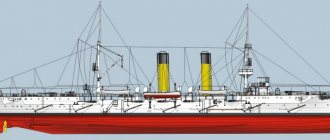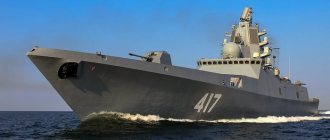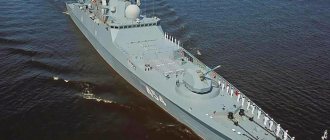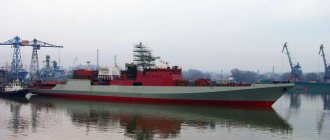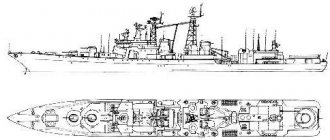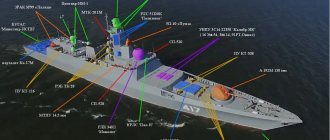TTD:
Displacement: 3860 tons. Dimensions: length - 124.8 m, width - 15.2 m, draft - 4.66 m. Full speed: 30 knots. Cruising range: 4850 miles at 14 knots. Powerplant: 2x6000 hp sustainer turbines, 2x17000 hp afterburner turbines, 2 fixed pitch propellers Armament: 1x8 vertical launcher UKSK (8 Kalibr-NK anti-ship missiles), 2x12 vertical launchers of the Shtil-1 air defense system (24 anti-aircraft missiles), 1x1 100 mm gun mount A-190-01 , 2x6 30 mm AK-630M gun mounts, 8x1 Igla-1 air defense missile system, 2x2 533 mm DTA-53-11356 torpedo tubes, 1x12 RBU-6000 launcher, 1x10 55 mm DP-65 grenade launcher, 1 Ka-27 helicopter. Crew: 220 people.
Ship history:
Frigate pr.11356
Project 11356 frigates are designed to conduct combat operations in oceanic and sea areas independently and as part of a formation of ships as an escort ship. The ship's combat capabilities allow it to search for and destroy enemy submarines; carry out anti-ship, anti-air and anti-submarine defense of warships and vessels at sea; support the combat operations of ground forces and ensure the landing of amphibious assault forces.
The ship's design was developed by the Federal State Unitary Enterprise "Northern Design Bureau" on the basis of the border patrol ship of Project 11351, and was originally intended for a foreign customer - the Indian Navy. According to this project, 6 ships were built for the Indian side at the Shipyards in St. Petersburg and Kaliningrad from 1999 to 2013, 3 units at each Shipyard.
The ship for the Russian Navy was created to accelerate the replenishment of the fleet, as a result of the delay in the implementation of Project 22350, and is intended for the Black Sea Fleet. The order of the Ministry of Defense of the Russian Federation received by the Yantar Shipyard in 2010 envisaged the construction of three frigates of Project 11356, but in the summer of 2011 it became known that the plant would build a total of 6 patrol ships of this project for the Russian Navy.
The ship's hull is forecastle-shaped, with an extended forecastle and fairly full contours in the above-water part of the bow. The ship has a three-island superstructure. The hull and superstructure of the ship are made of steel. When creating the ship, in order to increase its security and survivability, methods of architectural protection were used taking into account stealth technology, and measures were also implemented to reduce acoustic signature and protection from weapons of mass destruction. The main power plant is a two-shaft gas turbine unit of the COGAG type, consisting of two afterburning gas turbine engines (GTE) and two main gas turbine engines operating through complex gearboxes for two fixed-pitch propellers. The total power of the power plant is 56,000 hp.
The ship's armament includes 8 cells of the UKSK universal naval firing system, the A-190 universal automatic 100-mm artillery mount, the Shtil-1 anti-aircraft missile system, and two six-barreled rapid-fire 30-mm AK-630M mounts. The ship's anti-submarine and anti-torpedo protection is provided by two twin-tube 533-mm torpedo tubes and an RBU-6000 rocket launcher. The ship is equipped with a helicopter hangar and a landing pad, and carries on board one Ka-27 helicopter.
The patrol ship "Admiral Makarov" was laid down in Kaliningrad at the Baltic Shipyard "Yantar" on 02/29/2012 (serial number 01359), launched on 09/02/2015. In 2016, it was reclassified as a frigate. Entered the Black Sea Fleet on December 27, 2017.
On August 18, 2018, the patrol ship “Admiral Makarov” left Kronstadt to carry out an inter-fleet transition to Sevastopol, the main base of the Black Sea Fleet. After completing combat service tasks in the eastern part of the Mediterranean Sea, on October 5, 2018, the ship first arrived at the Main Base of the Russian Black Sea Fleet - Sevastopol.
Currently, the ship is listed as part of the 30th division of surface ships of the Black Sea Fleet.
This ship was commanded at different times by: - Captain 2nd Rank Grigory Breev; — captain 2nd rank Anton Kuprin; - Captain 2nd rank Sergei Romanenko.
A frigate with cruiser capabilities: what the Admiral Makarov can do
“The range of our onboard weapons is greater than that of ships of previous generations, and our combat capabilities are wider. The frigate is superior in many respects to large surface ships of NATO countries in the Black Sea region. In principle, in terms of the range of tasks it can perform, Admiral Makarov is comparable to our cruisers of recent series: we can strike ships and coastal targets, search for submarines using a helicopter and on-board equipment, monitor them and attack with torpedoes,” Breev told Krasnaya Zvezda "
The ship's main strike armament is universal launchers for eight Caliber and Onyx cruise missiles. The former are capable of hitting sea targets at a distance of 400 kilometers, and land targets at a distance of 2000 km. Supersonic Onyxes deliver a 300-kilogram warhead to the target and it is almost impossible to intercept a missile flying at Mach 2.6.
The frigate's air defense is organized into several echelons. At distant approaches, the threat is neutralized by anti-aircraft missiles of the Shtil-M complex, and nearby targets are shot down by six-barreled automatic guns AK-630M. The forecastle is equipped with a 100-mm AK-190 gun with a firing range of up to 21 kilometers. To combat submarines, the ship is equipped with a 12-barrel rocket launcher and four torpedo tubes capable of firing the latest generation of precision-guided ammunition.
— The frigate’s automation is the highest. The “Requirement-M” combat information and control system is used as the “brain” of all ship systems. It was developed specifically for ships of this project, which had a positive effect on its efficiency. The system manages all combat and defensive resources of the frigate, ensuring the automatic use of the entire range of weapons,” the commander noted.
The total power of the power plant is 56 thousand horsepower - this is enough to accelerate a ship with a displacement of four thousand tons to 30 knots and provide a cruising range of 5,000 nautical miles. By the way, during its service, Admiral Makarov has already covered 30 thousand miles.
St. Andrew's flag was raised on the frigate in December 2022. In the summer of 2018, the ship made the transition from the Baltic to the Black Sea Fleet, along the way taking part in large-scale exercises of the Russian Navy group in the Mediterranean Sea. On October 5, “Admiral Makarov” arrived in Sevastopol, and a month later went back to the Mediterranean Sea.
“The sailors of the new frigate are distinguished by high coherence in solving problems,” noted the deputy commander of the formation, captain of the first rank Sergei Radauskas. This means that they will display the St. Andrew’s flag in the Mediterranean with dignity.
"Admiral Makarov"
The frigate “Admiral Makarov” of project 11356, which was ordered for the Black Sea basin, was launched in early September of this year.
It became the third of six ships in the Project 11356 series. Admiral Grigorovich is undergoing sea trials. It hasn't been delivered yet. Mooring tests of the frigate Admiral Essen are underway. The ship has effective anti-ship weapons and air defense systems to successfully repel air strikes.
Design of new generation patrol boats
The decision to design a new patrol ship for the Russian Navy was made in the mid-90s. It was advisable to use the wealth of practical experience gained during the construction and operation of Project 1135 ships and especially Project 1135.1. Technologically, the design of the Burevestnikov provided ample opportunities to build a new ship through deep modernization.
In addition to the technological and production documentation developed during the construction of the “petrels” and “frosts”, for the design of new ships they tried to use data from the export version of ships of this class. In the export version, the project received the index 11356. These frigates, in the amount of 6 units, were to be built for the needs of the Indian Navy in 1999-2013. The domestic project received the index 11356Р/М under the code “Burevestnik”. According to NATO classification, new Russian ships were assigned the code “Krivak V” even at the construction stage.
During the creation of the project, all the best from the ships of its predecessors was taken. If in terms of the main design of the ships they bore the imprint of previous projects, the range of weapons and electronic equipment changed radically. The ships were to become universal, and weapons were selected accordingly. The design of the ship, which in the technical specifications was called a rank II patrol ship, was undertaken by the Northern Design Bureau, located in St. Petersburg. It was not unusual for the specialists of this enterprise to build such ships, and besides, the program for building Talwar-class frigates for India was moving forward at a good pace.
The designers were given the task of creating a ship whose construction technology would be identical to that used when fulfilling a foreign order. The main condition of the project was the preservation of the production cycle of ship construction, the technological and production capacities of the Kaliningrad shipbuilding plant. The program for the construction of new patrol ships was aimed at equipping the Black Sea Fleet. Based on the results of the analysis and study of the finished project, the Ministry of Defense of the Russian Federation in 2010 signed a contract for the construction of the first three ships intended to equip the Black Sea Fleet.
In the same year, the keel of the lead ship, the patrol ship Admiral Grigorovich, was laid down at the Yantar shipyard in Kaliningrad. Having assessed the scale and pace of construction of the lead ship, the Ministry of Defense in 2011 hastened to conclude another contract. The next three units were supposed to renew the ship composition of the Baltic Fleet. The total cost of the two contracts was 40 billion rubles. The new ships were supposed to enter service during 2014-17.
The second and third ships of Project 11356, the patrol ships Admiral Essen and Admiral Makarov, were laid down at the Kaliningrad shipyard in 2011 and 2012. The first two ships, the admiral, were launched at the end of 2014. Two years later, in March and June, both ships entered service, becoming full-fledged combat units of the Black Sea Fleet. The third ship of the first series, the frigate Admiral Makarov, is scheduled to be delivered at the end of 2022.
With the beginning of the Ukrainian-Russian military-diplomatic crisis, with the withdrawal of Crimea to the jurisdiction of the Russian Federation, it was decided to transfer all six ships built as part of defense orders to the Black Sea Fleet. Russia's participation in resolving the Syrian crisis has only strengthened this position. The new frigates should strengthen the naval group of the Russian Navy not only in the Black Sea, but also in the Eastern Mediterranean.
The three patrol ships remaining under existing contracts, Admiral Butakov, Admiral Istomin and Admiral Kornilov, were launched and are being completed afloat. The ships are scheduled to enter the fleet in 2022.
Recently, information leaked to the Russian media that the construction of ships of this project will continue. In the future, new frigates will be built for the Pacific Fleet. This order may include the capacity of the Amur Shipyard in Komsomolsk-on-Amur, which is currently implementing the project 22380 corvette construction program.
Creation of new patrol boats: need or urgent need of the fleet
A paradoxical situation has developed in the Russian Navy since the beginning of the new millennium. Most of the warships in the fleet were still Soviet-built. For their time, these were powerful and reliable ships, but by the end of the 90s, most of this legacy was technically worn out and obsolete. The difficult economic situation in Russia after the collapse of the Soviet Union had a particularly negative impact on the state of the naval personnel of the Russian Navy. Large warships, cruisers, large anti-submarine ships and destroyers rusted by the dozens against the quay wall. The fleet not only lost precious combat units. Russia was rapidly losing its position as a maritime power.
The sad situation of the fleet's combat readiness was somewhat smoothed over by the Project 1135M ships in the fleet at that time. "Burevestniki" - Soviet-built patrol ships were perhaps the most modern ships of the young Russian fleet. What saved the situation with the fleet was not only the satisfactory technical condition of ships of this type. The number of ships delivered to the fleet at one time allowed the naval command to close gaps and gaps in the defensive naval strategy.
Despite the fact that the strength reserve and technological resource of the ships of Project 1135M and 1135M1 were quite large, time was merciless. The proven "Burevestniks" were to be replaced by ships of a new generation, which were the patrol ships of Project 11356. The oldest fleets of the country, the Black Sea and Baltic, where they no longer remembered the new ships, were especially in dire need of such ships.
Patrol ships have always been and are one of the main classes of ships for the Russian fleet. In the West, domestic patrol ships are classified as frigates and corvettes. This is facilitated by the versatility and versatility of ships of this class. Modern corvettes and frigates are capable of performing a huge range of combat missions, especially in modern conditions, when it is technically possible to install almost any weapon on a ship.
Ship tasks
The main function of these ships is to protect relatively low-speed convoys from attack by submarines. Therefore, compared to a full-fledged destroyer, an escort destroyer has lower speed, less tonnage and less armament. However, later, with the development of technology and the use of nuclear power plants, it was possible to sharply increase the speed of submarines, as a result of which high-speed patrol boats were needed. The development of anti-ship missiles required strengthening of anti-aircraft weapons. Therefore, in the end, the difference between a patrol ship and a destroyer is price and displacement.
Project 11356 today
The decision to begin construction of new domestic patrol boats can be considered timely. Project 11356 ships meet modern requirements for naval warfare and are equipped with the most advanced communications and radar equipment. The weapons complex allows ships to solve a wide variety of tactical tasks, including conducting strike and defensive operations. The operation of the first two ships of the project, “Admiral Grigorovich” and “Admiral Essen,” pointed to a number of existing shortcomings in the design of the ships. During subsequent revisions, the identified defects were eliminated and adjustments were made to the design of the ships under construction.
The combat patrols recently carried out in the Eastern Mediterranean by the Russian Navy frigates Admiral Grigorovich and Admiral Essen clearly demonstrated the high seaworthiness and tactical and technical characteristics of ships of this class.
Comparison with project 22350
Project 22350 is being implemented along with project 11356. Let's compare the frigates of project 11356 and 22350. As an air defense system, instead of Shtil-1, there are 3S14U1 firing systems and Poliment-Redut air defense systems. For anti-ship protection, instead of "Caliber-NK", the "Onyx" or "Caliber-NKE" complexes are used. These weapons make it possible to effectively use the Project 11356 frigate against American ships.
Anti-submarine equipment of Project 22350 frigates is the Medvedka-2 launch complexes. The ship's artillery armament has also undergone changes. The 100 mm A-190 artillery mount was replaced by the 130 mm A-192, firing at 22 km. At the same time, frigates of projects 11356 and 22350 have much in common - both projects are equipped with very modern weapons.
Indian order
In the 90s, the development of the fleet almost stopped.
Factories tried to survive on export orders. Russia has a long history of cooperation with the Indian Navy, which constantly worked with Soviet shipbuilders in the field of procurement of domestic ships and in the field of consulting for Indian designers. India, conducting its own developments, became interested in the export version of the Project 11351 patrol ship - Project 11356. Even in the initial stage, Project 11356 frigates were significantly different from Project 11351, which served as the prototype for the new development. RBU-6000 were replaced by Uran missile launchers for anti-ship defense. Further, the trends of the times and the wishes of the Indian customer radically changed the appearance and contents of the frigate.
Armaments
Anti-ship complex "Caliber-NK2.
The A-190 artillery system allows you to fire at sea and air targets. Air defense system "Shtil-1" with all-round radar. The anti-submarine complex consists of 533-mm torpedo tubes of the DTA-53-11356-2 modification and an RBU-6000 bombing system.
The Fregat-M2EM radar is used as a hydroacoustic weapon, detecting and tracking submarines.
To operate helicopters, the frigate is equipped with a hangar and a takeoff and landing platform. Such weapons make the Project 11356 frigate Admiral Makarov a formidable force.
